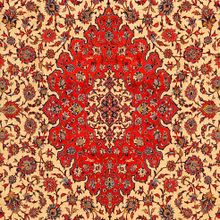Isfahan Rug
| Isfahan Rug | |
|---|---|
 Design of Isfahan Rug (Rugman) | |
| General information | |
| Name | Isfahan Rug |
| Original name | قالی اصفهان |
| Alternative name(s) | Isfahan Carpet |
| Origin | |
| Category | City |
| Technical information | |
| Common designs | Lachak Toranj, Tree, Arabesque (Eslimi) |
| Common colors | Crimson, Cream, Navy Blue, Ruby, Begie, Blue |
| Dyeing method | Natural, Synthetic |
| Pile material | Silk |
| Foundation material | Silk, Cotton |
| Knot type | Asymmetrical (Persian), Jufti |
Isfahan rugs originate from Isfahan, located between two mountain ranges just south of Tehran, Isfahan is the capital city of the province. The weaving of Isfahan rugs dates back to the 16th century. During its peak in the 17th century Isfahan became the capital of Iran. The most sought after Isfahan rugs are made by the very famous master weaver, Serafian. These rugs are in such great demand that a whole industry of counterfeit Serafian traditional rugs now exists. Buyer beware. The best protection is to purchase Isfahan rugs only from a reputable dealer who will provide a certificate of authentication. The skilled artisans of authentic Isfahan rugs ply their trade using Persian knots with varying KPSI (knots per square inch), depending on the quality of the rug.
History
Materials
Foundation and Pile
Isfahan carpets of the Safavid period usually have a cotton foundation and a wool pile. Some other notable materials used for the woven foundation are a silk warp and cotton weft foundation with a wool pile; a cotton warp and silk weft foundation with a wool pile; and an all-silk foundation with a silk pile. A few Isfahan wool pile carpets were woven with silk highlights. There are some Isfahan rugs brocaded with gold or silver metallic thread, silk warps, and areas of silk pile.
In addition, a number of tapestry-woven Isfahan carpets were created with a silk foundation of high quality.[1]
During the second quarter of the twentieth century many Isfahan weavers switched the foundation from cotton to silk and continued to make high-quality carpets in the traditional style.
After World War II the city of Isfahan and the surrounding suburbs continued the use of cotton foundation.[2]
Techniques and structures
Color and dyeing
The field color of Ahmad rugs is mainly dark blue; ivory and red were also made.
Many Isfahan carpets are on an ivory background with various shades of reds, blues, greens, gold, cinnamon, and browns for the design elements, medallion, and borders.[3]
Motifs and Designs
Shoreshi’s popular designs are the Shah Abbas style, the Shrub, and the Tree of Life. The shrub and tree of life designs are truly special and present the great art of Isfahan. These designs have several different garden shrubs with beautifully woven animals and birds in the field and border. Another Shoreshi design is the allover or center medallion with Shah Abbas style in the background and borders. Shoreshi used popular Safavid motifs in a more refined and delicate format and displayed them on an ivory background. This creative style greatly influenced Isfahan weavers, who continue to manufacture the style up to this day. The town of NAIN, located sixty-two miles (100 km) away from Isfahan, widely produced this Shoreshi style and became an important weaving town for domestic needs and foreign export.
Ahmad also made a number of designs. One popular style is the medallion with a delicate Shah Abbas palmette with flowers, leaves, and vines. Another well-known Ahmad rug style is the beautiful tree of life, featuring birds and animals in the design. The tree of life rugs by Ahmad are high in grade quality and are valuable in the antique market today.
After World War II the city of Isfahan and the surrounding suburbs continued the use traditional Shah Abbas styles.[4]
Weaving techniques
The Persian (asymmetric) knot was used for all Isfahan pile carpets and rugs during this period.[5]
The Ahmad Isfahan rugs are known for the smaller sizes, which range approximately five feet by three feet to seven feet by four feet six inches.
The sizes of Isfahan weavings range from small pillows to large palace dimensions. Safavid-period Isfahan weavings were made in sizes ranging from approximately three feet square to forty-five feet in length carpets, with most originally made in long and narrow gallery formats.[6]
See also
References
Bibliography
Abraham Levi Moheban, (2015), The Encyclopedia of Antique Carpets: Twenty-Five Centuries of Weaving, NewYork: Princeton Architectural Press.